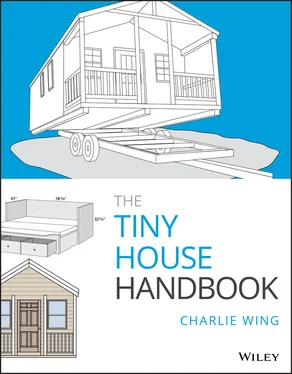Of course detailed architectural plans include such things as:
• sizes of floor joists and roof rafters
• stairway dimensions
• minimum clearances for doorways, halls, and plumbing fixtures
• locations and ratings of electrical receptacles
All of these are regulated by building codes, which we address next.
Building Codes
Local building codes are usually based on the International Residential Code (IRC). Both states and local jurisdictions are free to modify the IRC, but until a local code enforcement official states otherwise, consider the IRC your bible.
How do you make sure your tiny house design meets the Code? Here are the possible ways:
• Have it built by a tiny home manufacturer (expensive, but the simplest way).
• Have it designed by a local architect (adds 10–15% to the project cost).
• Follow this book’s directions, then pay to have your plans reviewed by an architect.
• Provided your local code enforcement officer really likes you, follow the directions in this book, meeting often with him or her to guide your progress.
Permits and Variances
Before building you will have to obtain permits. In a small town the permits may be issued by a single code enforcement officer. In heavily populated cities and towns you or your builder will have to present your plans to the planning board for approval. Often you will need to resubmit your plans after making changes requested by the board members.
Sometimes the board will turn down your application because it fails to meet a fundamental zoning requirement. In the case of a tiny home, this will most likely be size. If the planning board refuses to grant your application a variance, your final option would be an appearance at the separate zoning board of appeals. If determined to prevail you should at this point consider hiring a real estate attorney to help you present your case.
The IRC Minimum Size
With the exception of IRC Appendix Q , any tiny house (no larger than 400 sq.ft. habitable area) has to conform to the same IRC requirements as any other one- and two-family dwelling. Since size is of such critical importance, it bears listing the IRC main body regulations regarding size:
R304.1 Minimum area. Habitable rooms shall have a floor area of not less than 70 square feet.
R304.2 Minimum dimensions. Habitable rooms shall be not less than 7 feet in any horizontal dimension.
Exception: Kitchens.
R304.3 Height effect on room area. Portions of a room with a sloping ceiling measuring less than 5 feet or a furred ceiling measuring less than 7 feet from the finished floor to the finished ceiling shall not be considered as contributing to the minimum required habitable area for that room.
R306.1 Toilet facilities. Every dwelling unit shall be provided with a water closet, lavatory, and a bathtub or shower.
R306.2 Kitchen. Each dwelling unit shall be provided with a kitchen area, and every kitchen area shall be provided with a sink.
NOTE: The minimum area of a bathroom containing the three fixtures listed in R306.1 and conforming to the minimum fixture clearances shown on page 35 is 18 square feet.
Since R306.2 refers to a kitchen area, not a separate kitchen, the kitchen may be part of the minimum habitable room of R304.1. Thus the minimum total area of a dwelling can be as little as 70 + 18 = 88 square feet!
IRC Appendix Q: Tiny Houses
The provisions contained in this appendix are not mandatory unless specifically referenced in the adopting ordinance.
User note:
About this appendix: Appendix Q relaxes various requirements in the body of the code as they apply to houses that are 400 square feet in area or less. Attention is specifically paid to features such as compact stairs, including stair handrails and headroom, ladders, reduced ceiling heights in lofts and guard and emergency escape and rescue opening requirements at lofts.
GENERAL
AQ101.1 Scope. This appendix shall be applicable to tiny houses used as single dwelling units . Tiny houses shall comply with this code except as otherwise stated in this appendix.
DEFINITIONS
AQ102.1 General. The following words and terms shall, for the purposes of this appendix, have the meanings shown herein. Refer to Chapter 2 2 LEGAL ASPECTS You are excited; you are motivated; you are ready to begin a life based on need, not greed, in a shelter that sustains you, not drains you. This book is designed to provide the information you need to realize your dream, but first a dose of reality. While 90% of the world’s 7,800,000,000 people live in just 200 square feet per person, the average allocation for Americans has bloated to 832 square feet. Why so big? Because, like so many other aspects of the American way, we could. The size of one’s home has become a status symbol. The towns we live in speak to who we are. This has been going on since the end of World War II—long enough for minimum lot size and minimum house size to creep into our zoning ordinances. The reality is that you will have a difficult time obtaining a building permit for your tiny home in affluent residential areas. But there is often an out. Even the affluent like to have family nearby. There is an equally long history of zoning allowances for accessory dwelling units, so-called “granny flats.” Very often the size minimum, if there is one, falls within the 400 square foot “tiny house” range. Then there are the building codes. Your house may be tiny, but it still must meet building, electrical, and plumbing codes. But relax. These codes are not designed to stop you. They are designed solely to keep you safe and healthy. Embrace them.
of this Code for general definitions.
EGRESS ROOF ACCESS WINDOW. A skylight or roof window designed and installed to satisfy the emergency escape and rescue opening requirements of Section R310.2.
LANDING PLATFORM. A landing provided as the top step of a stairway accessing a loft .
LOFT. A floor level located more than 30 inches above the main floor, open to the main floor on one or more sides with a ceiling height of less than 6 feet 8 inches and used as a living or sleeping space.
TINY HOUSE. A dwelling that is 400 square feet or less in floor area excluding lofts .
CEILING HEIGHT
AQ103.1 Minimum ceiling height. Habitable space and hallways in tiny houses shall have a ceiling height of not less than 6 feet 8 inches. Bathrooms, toilet rooms and kitchens shall have a ceiling height of not less than 6 feet 4 inches. Obstructions including, but not limited to, beams, girders, ducts and lighting, shall not extend below these minimum ceiling heights.
LOFTS
AQ104.1 Minimum Loft Area & Dimensions Lofts used as a sleeping or living space shall meet the minimum area and dimension requirements of Sections AQ104.1.1 through AQ104.1.3.
AQ 104.1.1 Minimum area. Lofts shall have a floor area of not less than 35 square feet.
AQ 104.1.2 Minimum dimensions. Lofts shall be not less than 5 feet in any horizontal dimension.
Читать дальше












